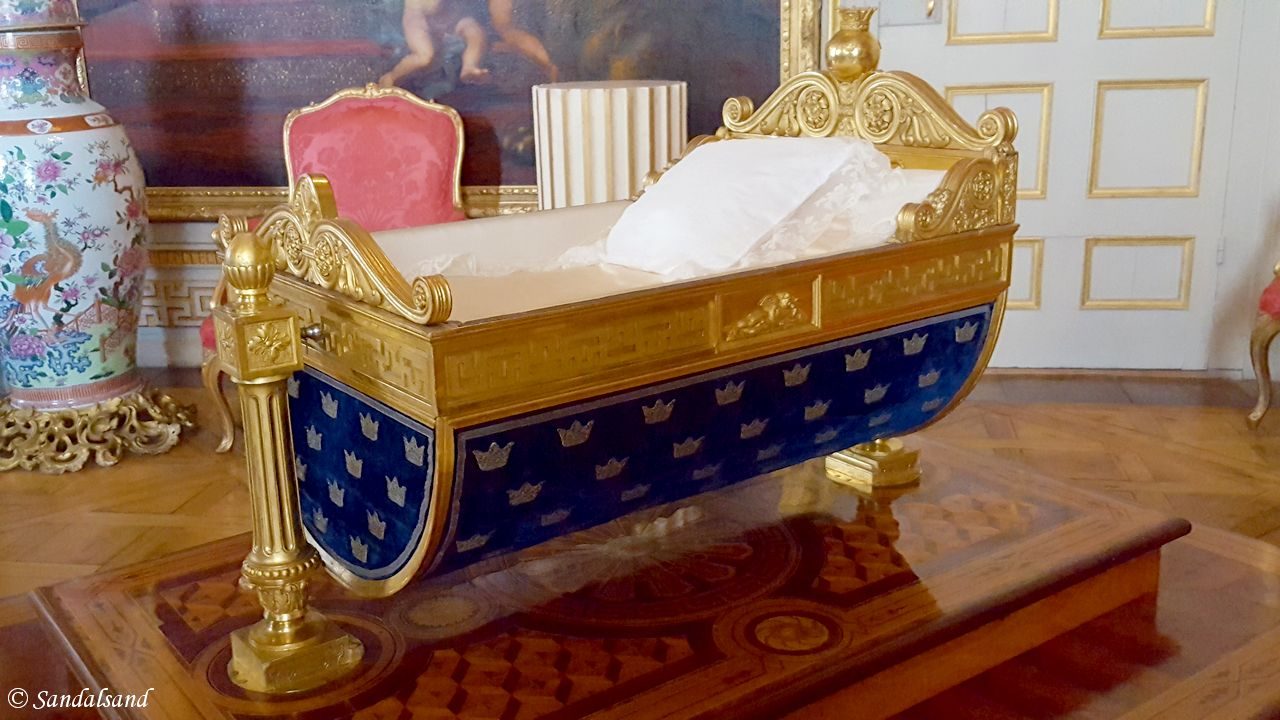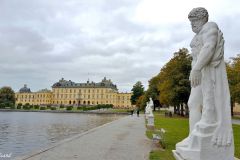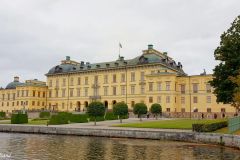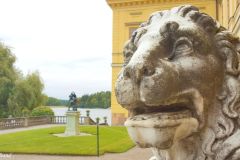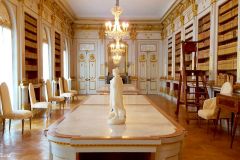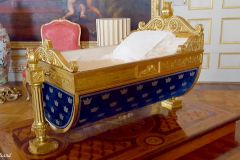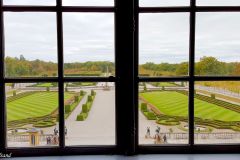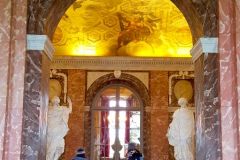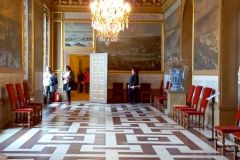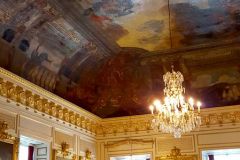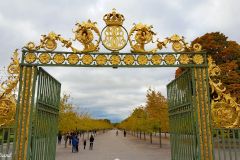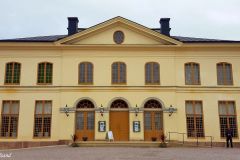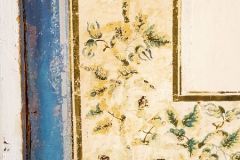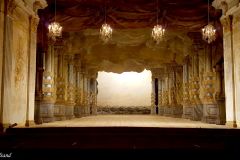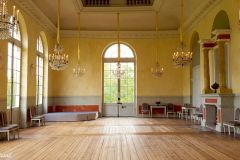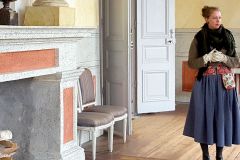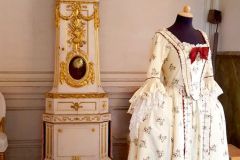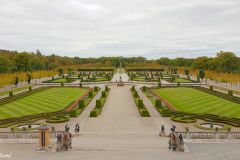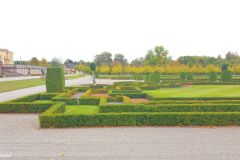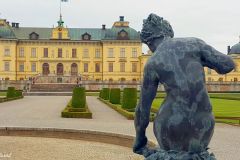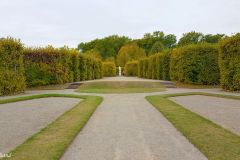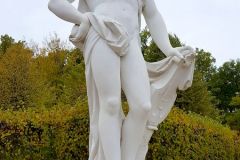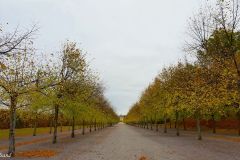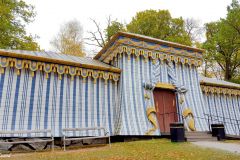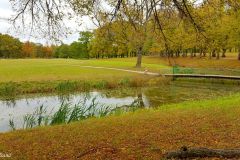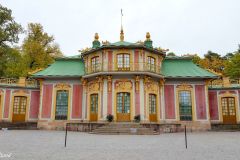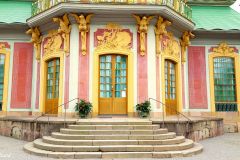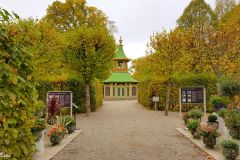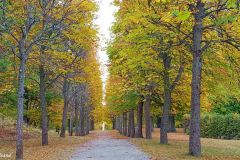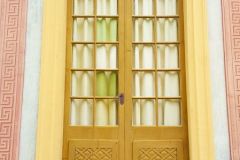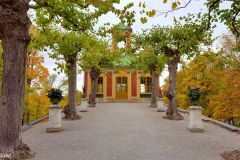The Drottningholm Palace is the Versailles of northern Europe. The royal palace offers a spectacular way of getting behind the curtains to discover how one of Europe’s royal families has been living for 350 years. Drottningholm is even today the private residence of the majesties of Sweden.
You will find practical information, and a map, at the end of this article. My description follows my own sequence at the visit, but there are more, or less, to be seen as well. It all depends on your interests.
The highlights:
- The palace’s exterior has remained roughly the same since the late 1600s, and the interior with its reception halls and bedrooms cover all kinds of royal fashion shifts ever since.
- The court theatre across the courtyard was completed in 1766. Its auditorium has remained (almost) unchanged ever since.
- The park is so large, and its gardens so varied, that you will get a nice little exercise just by walking from one end to the other.
- And you should, because at the far end you will find the Chinese Pavilion, also from the 1760s.
Drottningholm Slott (The palace)
The name literally translates as Queen’s island. It dates back to the end of the 16th century when King Johann III built the first palace here for his consort, the Queen. The palace was destroyed in a fire in 1661, following which the Queen Dowager, Hedvig Eleonora, rebuilt it. She commissioned the architect Nikodemus Tessin the Elder to design a new palace, and it is this we may visit today. At that time Sweden was reckoned as one of the major power in Europe, and this would be reflected in the standard of a royal palace.
The interior has however changed substantially over the years, as a result of changing fashions, ideas and initiatives by later queens and kings, most notably Lovisa Ulrika and Gustav III.
Tessin’s fascination with the contemporary Baroque style is reflected in the staircase, the Ehrenstrahl Drawing Room and Hedvig Eleonora’s State Bedchamber. Tessin’s son completed his father’s work after 1682.
Drottningholm lived up to its name as residence of the royal ladies even after Hedvig Eleonora. The Prussian princess Lovisa Ulrika received in 1744 Drottningholm as a wedding gift from Adolf Fredrik, the crown prince. She more than others introduced arts to the palace and new foreign inspiration like the Rococo style Green Antechamber.
You will be able to study the exterior of the palace from a distance, as you arrive and from the side facing the park. There are guided tours inside, but it is also possible to walk around at your own pace. A fee is paid at the entrance. Even if you have been to a European palace before, this one is truly spectacular. Don’t miss the opportunity to look out the windows at the park and lake.
Drottningholms Slottsteater (The theatre)
Next to the palace there are several buildings housing the royal guards (past and present) and the royal stables (past). There is also a courtyard with a rather modest looking building at the far end. That is the Slottsteater, or Court Theatre, built in 1766.
Lovisa Ulrika was the lady behind the Drottningholm Court Theatre. It is not lavishly decorated in any way, and it even had seats at the back for members of the public. Apart from that this is a royal theatre, used for a variety of plays between its opening in 1766 till it was closed in 1792. The last 15 years before that is considered the best period, introducing comical operas, classical drama and pantomime ballets to the audience.
The theatre fell into a long sleep. Like the “Sleeping beauty” she was awakened many years later, in 1921. A period of gentle rehabilitation began. The robes were changed, cleaning was done, and electricity was installed. Around 30 decorated stage sets had been preserved.
Everything has now been taken into use by the revitalised theatre company, staging concerts and performances from the late 18th century. They are also allowing groups on guided tours, like the one I was lucky to join on my visit to Drottningholm.
A highlight is to sit in the auditorium and listen to the manually operated wind machine at work and also the thunder box. Even lightning is produced using technology from the 18th century. Next to the theatre proper there is a large room, the Déjeuner Salon, with a gorgeous view of the park, now open for rent. Think of receptions, weddings and the like – if you can.
The park and formal gardens
Orientation
After you have visited the palace and the theatre you will want to enter the large park through the golden gate. To your right you will have the large lawns and a couple of ponds belonging to the English park. To your left and directly facing the palace there is a formal garden called the Baroque garden. There is also a garden, or park, around the Chinese Pavilion at the farthest end of the property.
Three stages
In fact, the park and gardens of Drottningholm were developed in three stages, each with a different style. The French Baroque garden was established by Queen Hedvig Eleonora and her architects, the Tessins in the last half of the 17th century. At the centre you will notice the Hercules fountain by Adriaen de Vries. This and a number of other bronze sculptures in the park were brought here as war bounty, after successful victories in Prague and Fredriksborg (Denmark) in the mid 1600s.
You will on your walk be drawn forward on the tree lined avenues. There is a strict symmetry to be noticed, but also some marble sculptures appearing as out of nothing – adding to the lure of the park. Towards the end you turn slightly left and head for Kina Slott (The Chinese pavilion). This former hunting ground was turned into a park in the middle of the 18th century, relying on new ideas, that of a natural setting.
At the end of the 18th century another large area was set aside for a park, this time with inspiration from England. Not every building that was planned to be included in the park was completed. You may however want to have a look at the neo-Gothic tower on the outskirts. There was even a maze. Originally the path would be surrounded by high bushes, now only marked with grass on the ground. The distance to the marble statue at the centre is about 2,5 km, following the old path, or 100 metres if you go straight in.
Maintenance
During the 19th century and first half of the 20th century the park and gardens were poorly maintained, but have during the last decades been brought back to roughly the layout they had in the old days.
The park is open for free all year round.
Kina Slott (The Chinese Pavilion)
In 1753 Queen Lovisa Ulrika received a surprise present on her 33rd birthday. Her husband, the king, had built a small Chinese inspired palace at the far end of the palace park.
At that time the royals and nobility of Europe were crazy about everything Chinese. Chinoiserie as it was called not only involved Ming vases and intricately made cupboards. A complete palace, or rather pavilion, must have been a popular gift. The surprise was complete when the Queen’s own son stepped out of the building dressed like a Chinese prince.
The 1753 palace was replaced in 1760 by a more permanent one, the one we can visit today all year round. Arriving here, you will have passed Vakttältet – the tent put up to house the royal guards near the pavilion. Today’s tent is a replica of the original from 1781.
You can get to the pavilion and walk around it, for free, all year round. During the summer it is possible to get inside to admire the combination of Rococo furniture and Chinese elements. The chinoiserie in Kina slott represents one of the most authentic collections of its kind in Europe. There is an entrance fee which includes a guided tour. Close to the pavilion you will find a nice little café perfect for a Swedish fika.
You will notice that there are several smaller buildings, also China style, around the main palace. Have a look into the garden to the left of the pavilion as well. Like the theatre, the Chinese Pavilion slumbered into a long sleep after 1792. This explains why Drottningholm is so special even today – time has stood still for a very long time.
Conclusion
Drottningholm Palace has since 1991 been inscribed on UNESCO’s prestigious World Heritage List: “The ensemble of Drottningholm – palace, theatre, Chinese pavilion and gardens – is the best example of a royal residence built in the 18th century in Sweden and is representative of all European architecture of that period, heir to the influences exerted by the Chateau of Versailles on the construction of royal residences in western, central and northern Europe.”
No less. I rest my pen (aka keyboard).
How to get there
It will take you little more than 30 minutes to get here from central Stockholm. Take metro 19 to Brommaplan and then board a bus (for instance 176 or 177) to the Palace. The bus stop is at the entrance to the palace grounds. The same ticket covers both metro and bus. There is also a boat service during the summer from the City Hall. Find out more on the official website of Drottningholm Palace.
There is a visitor’s centre near the main entrance to the Drottningholm Palace, with a gift shop and restaurant.
Here on Sandalsand you may read other articles about what to see in and around Stockholm:
- Gamla Stan and other highlights
- World Heritage List #0558 – Skogskyrkogården
- What to do revisiting the city?
- A visit to Drottningholm Palace (THIS)
- World Heritage List #0559 – Royal Domain of Drottningholm

